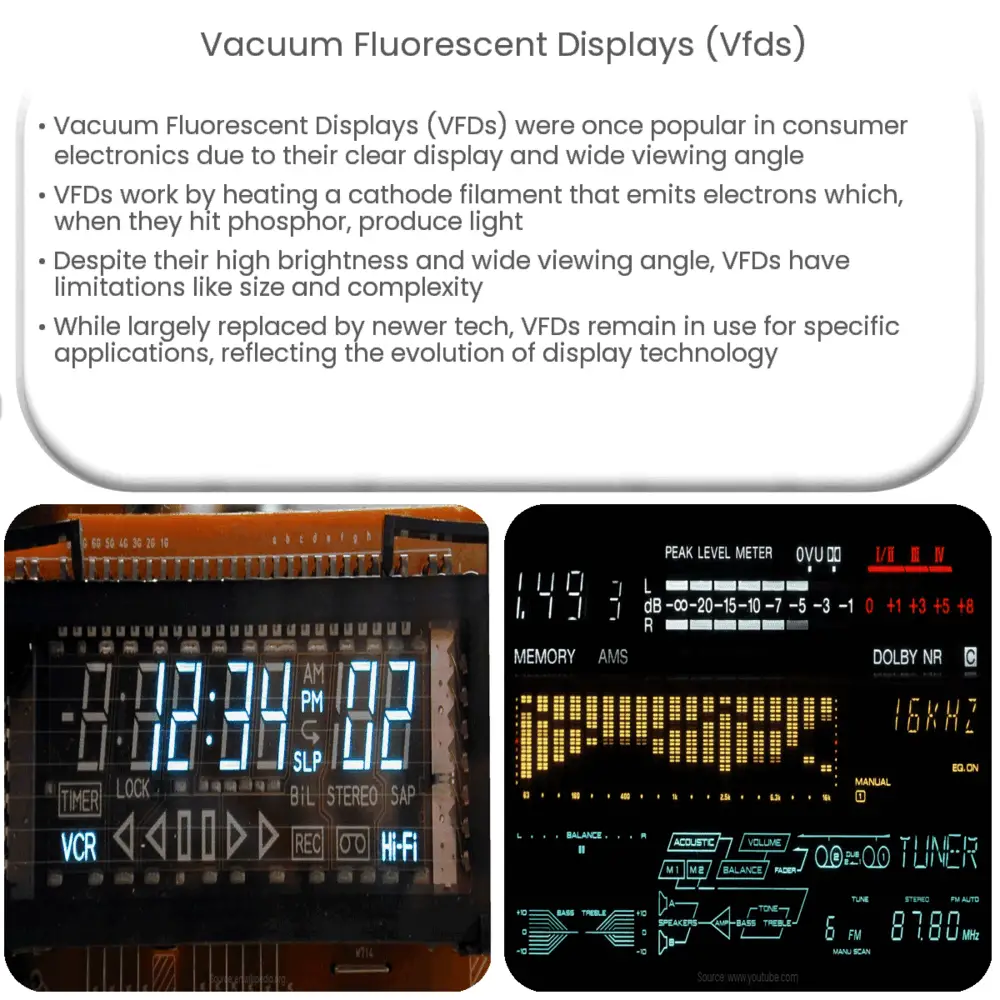Explore the world of Vacuum Fluorescent Displays (VFDs), their working mechanism, advantages, limitations, and modern uses.

Introduction to Vacuum Fluorescent Displays (VFDs)
Vacuum Fluorescent Displays (VFDs) are a type of display technology that was once widely used in consumer electronics, car radios, and microwave oven displays. The bright, clear display and wide viewing angle made them popular for these applications.
Working Mechanism of VFDs
At the heart of a VFD is a cathode filament that emits electrons when heated. This is surrounded by a control grid, an anode, and phosphor-coated glass. When a voltage is applied, the electrons are attracted to the anode and pass through the control grid. As they reach the anode, they hit the phosphor, causing it to emit light. This is how the VFD produces its distinctive bright, clear display.
Components of a VFD
- Cathode: This is the part that emits electrons when heated. It’s usually made of a thin wire of tungsten.
- Control Grid: This is a grid of wires that controls the flow of electrons. When a voltage is applied to it, it allows the electrons to pass through.
- Anode: This is the part that attracts the electrons. It’s usually made of metal and coated with phosphor.
- Phosphor: This is the material that emits light when it is hit by the electrons. It’s usually applied as a thin layer on the inside of the glass.
Advantages of VFDs
VFDs have several advantages that made them popular for many applications. These include:
- High Brightness: VFDs are much brighter than other types of displays, making them easy to read even in direct sunlight.
- Wide Viewing Angle: VFDs can be viewed from almost any angle, unlike LCDs, which have a limited viewing angle.
- Low Power Consumption: Despite their brightness, VFDs consume relatively low power compared to other types of displays.
In the following section, we will explore the limitations of VFDs, how they have been replaced by newer technologies, and the niche areas where they still find use today.
Limitations of VFDs
Despite the many advantages of VFDs, they have several limitations that have led to them being replaced by other types of display technologies in many applications:
- Size: VFDs are larger and bulkier than other types of displays, which limits their use in compact devices.
- Complexity: VFDs are more complex to manufacture than other types of displays, which makes them more expensive.
- Limited Lifespan: The cathode in a VFD gradually wears out over time, which reduces the brightness of the display.
- Power Efficiency: While VFDs are more power-efficient than some types of displays, they are less efficient than modern LED and OLED displays.
VFDs in the Modern Era
Despite these limitations, VFDs still find use in some niche applications where their unique advantages are beneficial. For instance, they are still used in some high-end audio equipment because of their distinctive aesthetic. They are also used in some industrial applications where high brightness and a wide viewing angle are important.
Conclusion
In conclusion, Vacuum Fluorescent Displays, or VFDs, are a unique type of display technology that were once widely used in consumer electronics, car radios, and various other applications. While they have largely been replaced by newer technologies due to their limitations, they still find use in certain niche areas. The story of the VFD is a perfect illustration of the relentless pace of technology; it’s a story of innovation and obsolescence, of benefits and limitations. Despite their decline in popularity, VFDs still hold a unique place in the history of display technology, a testament to the era in which they were most prominent.

